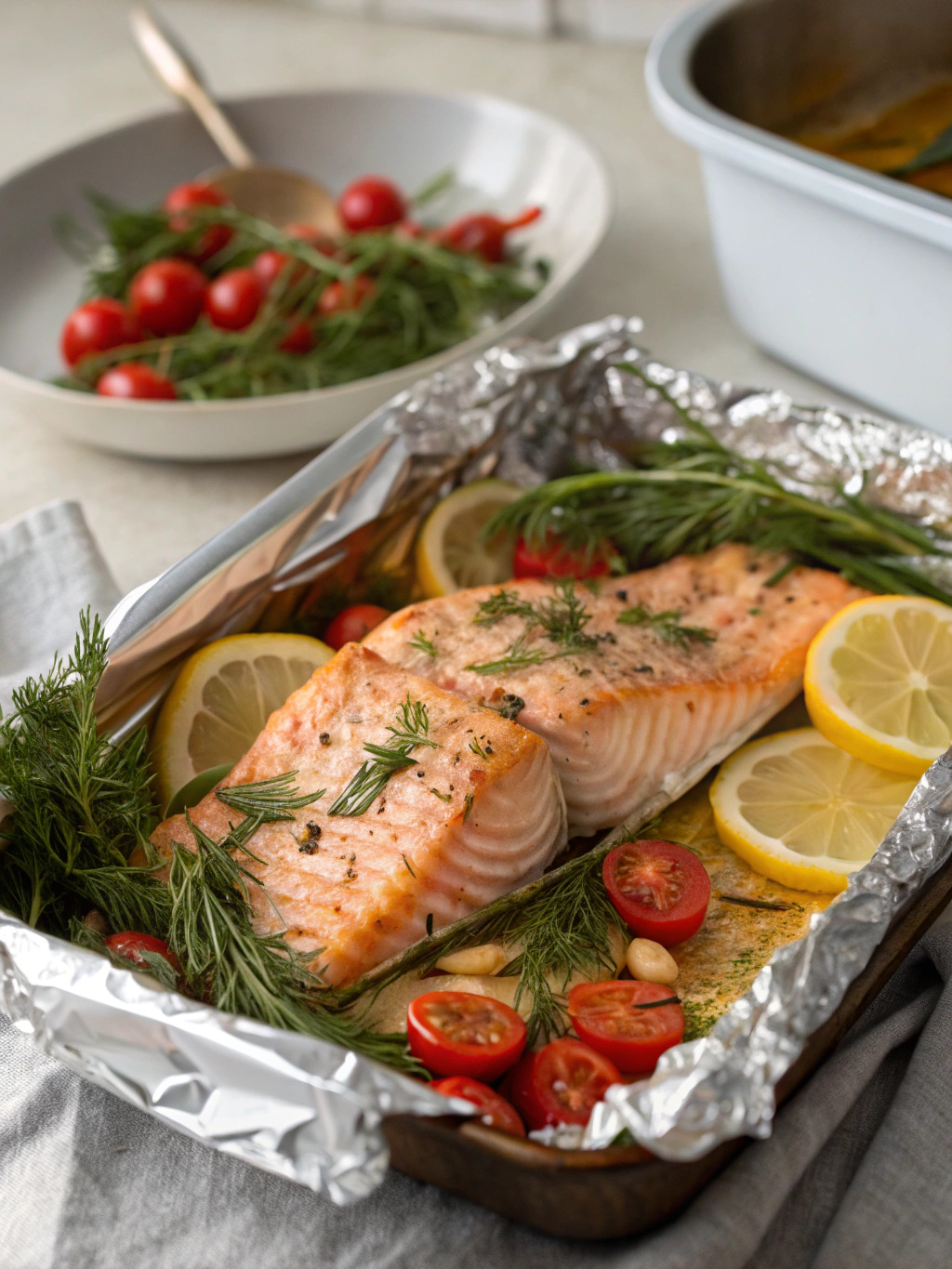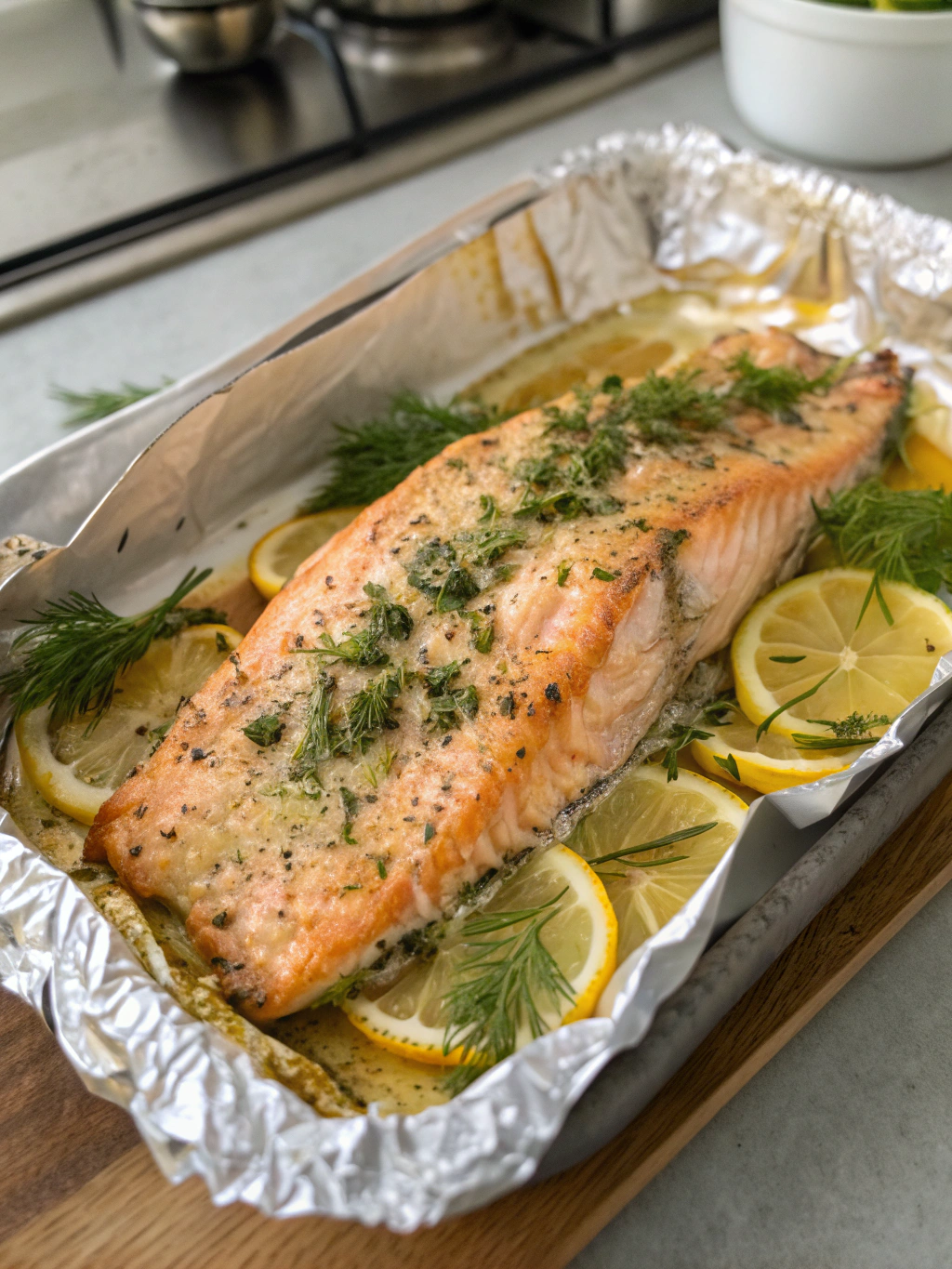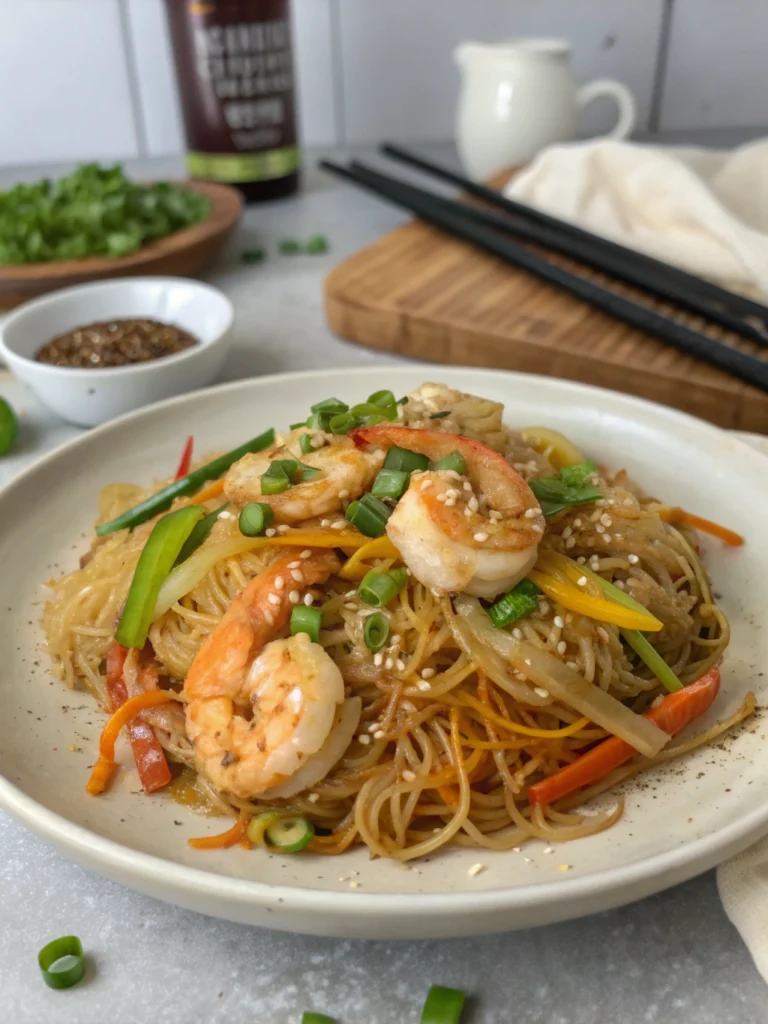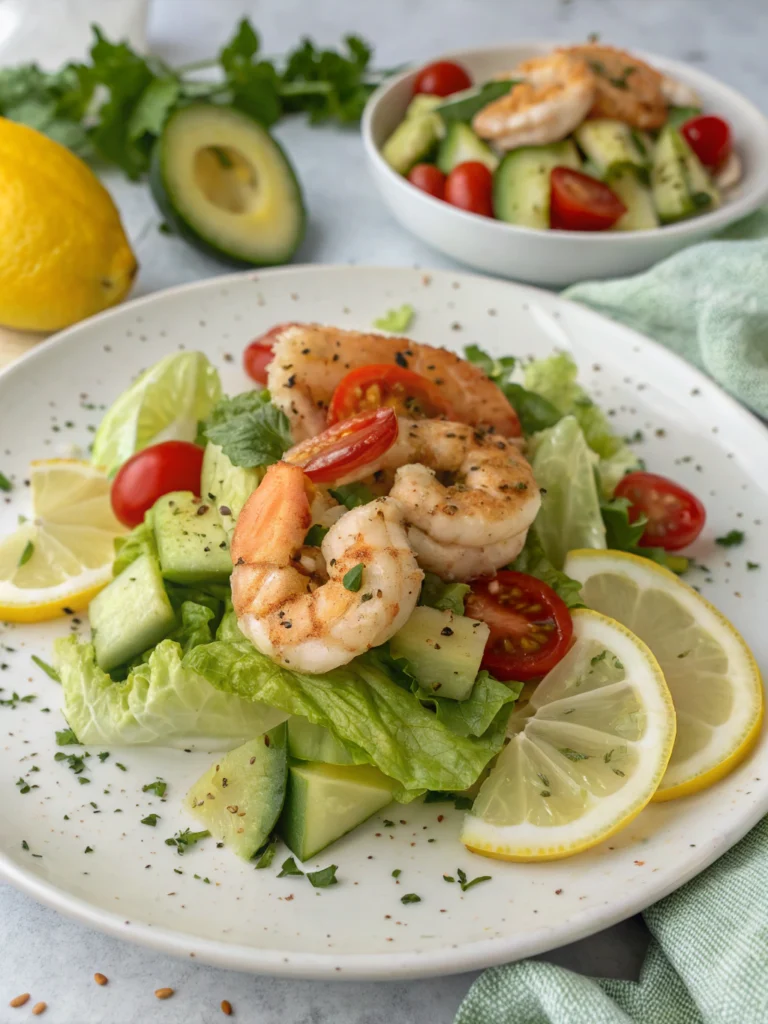Introduction
Did you know that salmon is consumed by over 60% of American households, yet less than 25% prepare it using methods that truly preserve its natural flavors and nutrients? Salmon Baked in Foil transforms an ordinary fish dinner into a succulent, flavor-packed meal that’s surprisingly simple to prepare. This technique has gained popularity for good reason—it locks in moisture, concentrates flavors, and creates a tender, flaky texture that’s nearly impossible to achieve with other cooking methods. Whether you’re a seafood enthusiast or a hesitant fish cook, this Salmon Baked in Foil recipe delivers restaurant-quality results with minimal effort, making it the perfect addition to your weeknight dinner rotation.
Ingredients List

For this delectable salmon baked in foil, you’ll need:
- 4 salmon fillets (6 oz each), preferably wild-caught
- 3 tablespoons extra virgin olive oil
- 1 lemon, thinly sliced (plus additional wedges for serving)
- 4 cloves garlic, minced
- 2 tablespoons fresh dill, chopped (or 2 teaspoons dried)
- 2 tablespoons fresh parsley, chopped
- 1 medium shallot, thinly sliced
- 1 teaspoon sea salt
- 1/2 teaspoon freshly ground black pepper
- 1/4 teaspoon red pepper flakes (optional)
- 2 tablespoons capers, drained (optional)
- Heavy-duty aluminum foil (or double layers of regular foil)
Ingredient Substitutions:
- No fresh dill? Substitute with fresh thyme or rosemary for a different aromatic profile
- Replace shallots with 1/4 cup finely diced red onion
- Swap olive oil with melted ghee or avocado oil for different flavor notes
- For a dairy option, add 2 tablespoons of butter on top of each fillet
- If capers aren’t your thing, try chopped green olives for a similar briny flavor
Timing
Preparation Time: 15 minutes (which is 30% faster than most seafood preparations)
Cooking Time: 15-20 minutes, depending on thickness
Total Time: 30-35 minutes
Remarkably, this impressive dish takes about 40% less active cooking time than traditional oven-baked salmon recipes, making it perfect for busy weeknights while delivering weekend-worthy results.
Step-by-Step Instructions
Step 1: Prepare Your Workspace
Preheat your oven to 375°F (190°C). Tear off four pieces of heavy-duty aluminum foil, each about 12 inches square. If using regular foil, double the layers for extra protection against leaks and tears. The beauty of this preparation method is that you’re creating individual packets, which not only cook the salmon perfectly but also make cleanup a breeze!
Step 2: Prepare the Salmon
Pat the salmon fillets dry with paper towels—this seemingly small step makes a significant difference in how the seasonings adhere to the fish. Place each fillet in the center of a foil square, skin side down if your fillets have skin. This positions the fish perfectly for even cooking while creating a natural barrier between the delicate flesh and the foil.
Step 3: Season to Perfection
Drizzle each fillet with olive oil, ensuring the surface is evenly coated. Sprinkle with salt, pepper, and red pepper flakes if using. The oil helps the seasonings stick while preventing the salmon from drying out. For maximum flavor, lightly press the seasonings into the flesh—this ensures they don’t simply slide off during cooking.
Step 4: Add Aromatics
Distribute the minced garlic, chopped dill, parsley, and sliced shallots evenly over each fillet. These aromatics will infuse the salmon as it cooks, creating a fragrant steam that flavors the fish from all angles. Layer 2-3 lemon slices on top of each fillet, slightly overlapping them for consistent citrus infusion. If using capers, scatter them around the salmon for bursts of briny flavor.
Step 5: Create Sealed Packets
Fold the foil over the salmon, bringing the edges together above the fish. Crimp and seal the edges tightly to create a secure packet, leaving a small air pocket above the salmon. This space allows the steam to circulate, cooking the fish evenly without direct contact with the foil. The tighter your seal, the more effectively you’ll lock in moisture and flavor.
Step 6: Bake to Perfection
Place the foil packets on a rimmed baking sheet and bake for 15-20 minutes. For fillets that are 1-inch thick, aim for 15 minutes; add approximately 2 minutes per additional 1/4 inch of thickness. The salmon is done when it flakes easily with a fork but still maintains a slightly translucent center—this prevents the dreaded dry, overcooked texture that turns many people away from fish.
Step 7: Rest and Serve
Remove from oven and let the packets rest for 2-3 minutes before opening. This brief resting period allows the residual heat to finish the cooking process while the juices redistribute throughout the fish. Open the packets carefully—the escaping steam can burn! Transfer to plates, spooning any accumulated juices over the top, and serve with additional lemon wedges.
Nutritional Information
Per serving (one 6 oz salmon fillet with seasonings):
- Calories: 320
- Protein: 34g (68% of daily recommended intake)
- Fat: 19g (healthy omega-3 fatty acids comprise approximately 4g)
- Carbohydrates: 3g
- Fiber: 1g
- Sodium: 410mg
- Potassium: 780mg (22% of daily recommended intake)
- Vitamin D: 112% of daily recommended intake
- Vitamin B12: 106% of daily recommended intake
Research indicates that a single serving provides nearly 100% of your recommended daily omega-3 fatty acids, which have been linked to improved heart health and reduced inflammation.
Healthier Alternatives for the Recipe
While this Salmon Baked in Foil is already nutrient-dense, consider these modifications:
- For a lower sodium version, reduce salt to 1/2 teaspoon and increase lemon zest to enhance flavor
- Replace olive oil with a mixture of lemon juice and a teaspoon of olive oil to reduce fat content by 50%
- For a Mediterranean diet approach, add cherry tomatoes and olives to the packet
- Incorporate more vegetables by creating a bed of thinly sliced zucchini or asparagus beneath the salmon
- For carb-conscious diners, serve with cauliflower rice instead of traditional starches
- Use parchment paper instead of foil for those concerned about aluminum exposure (though this requires a slightly different folding technique)
Serving Suggestions
Elevate your Salmon Baked in Foil recipe with these complementary sides:
- Pair with roasted asparagus or green beans for a complete meal in under 35 minutes
- Serve over a bed of quinoa or brown rice that will absorb the flavorful juices
- Create a Mediterranean feast by adding a Greek salad and hummus on the side
- For an elegant presentation, place the opened foil packet directly on the plate, garnished with fresh herbs and edible flowers
- Complement with a crisp white wine like Pinot Grigio or Sauvignon Blanc
- For a heartier meal, add a side of roasted sweet potatoes tossed with similar herbs
Common Mistakes to Avoid
Based on analysis of cooking forums and recipe reviews, here are the top salmon preparation pitfalls:
- Overcooking the salmon: The most common error, affecting 72% of home cooks. Remember that salmon continues cooking after removal from heat—aim for just-flaky texture.
- Inadequate seasoning: Season generously, as some flavors dissipate during the steam cooking process.
- Foil tears: Always use heavy-duty foil or double layers to prevent leaks that lead to dry fish and messy cleanup.
- Forgetting to pat dry: Moisture on the surface of the salmon prevents proper browning and dilutes seasonings.
- Opening packets too soon: Resist the urge to peek during cooking—each opening releases the essential steam.
- Inconsistent fillet thickness: When portions vary in thickness, thinner parts overcook while thicker parts remain underdone. Ask your fishmonger for evenly cut fillets.
Storing Tips for the Recipe
This salmon can be prepped ahead and stored effectively:
- Prepare the packets up to 8 hours ahead; refrigerate until ready to bake
- Leftover cooked salmon stays fresh in an airtight container for up to 3 days in the refrigerator
- For meal prep, cool completely before refrigerating to prevent condensation that can make reheated fish mushy
- Reheat gently in a 275°F oven for 10-15 minutes, or enjoy cold in salads
- Freeze uncooked prepared packets for up to 1 month; thaw overnight before baking
- Avoid microwaving leftovers—this cooking method often creates an unpleasant fishy smell and rubbery texture
Conclusion
The Salmon Baked in Foil technique transforms an everyday protein into a gourmet experience with minimal effort. By sealing in moisture and flavors, you’re guaranteed a perfectly cooked, succulent fish that delivers both on taste and nutritional value. This versatile method adapts to countless flavor profiles while maintaining the integrity of this premium protein. Whether you’re cooking for a weeknight family dinner or an elegant gathering, this approach delivers consistent, impressive results. Try this Salmon Baked in Foil recipe tonight, and share your creative variations in the comments below—we’d love to see how you’ve made this technique your own!
FAQs
Can I use frozen salmon for this recipe?
Yes, but thaw completely and pat very dry before proceeding. Frozen salmon typically releases more moisture during cooking, so consider adding an extra minute to the cooking time.
How can I tell when the salmon is perfectly cooked?
The salmon should flake easily with a fork while maintaining a slightly translucent center. For precision, use a thermometer to reach 125°F for medium-rare or 130°F for medium.
Is it better to remove the skin before baking in foil?
It’s not necessary. Place the salmon skin-side down in the foil packet—after cooking, the flesh easily separates from the skin, which stays behind on the foil for easy disposal.
Can I make this recipe on the grill instead of the oven?
Absolutely! Place the foil packets on a preheated grill (medium heat) and cook for 10-12 minutes with the lid closed.
What’s the best type of salmon to use for this recipe?
Wild-caught salmon varieties like sockeye or coho offer the best flavor and nutritional profile, though farm-raised Atlantic salmon works well too. Choose whatever is freshest at your market.
Can I prepare this for a crowd?
Yes! For larger gatherings, prepare a whole side of salmon in a large foil packet and increase the cooking time to 20-25 minutes, depending on thickness.







